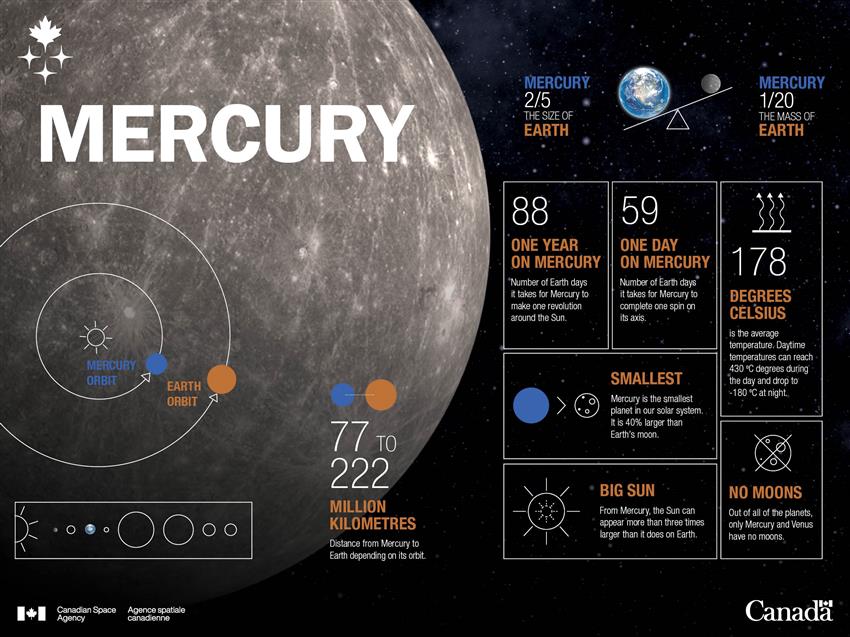Mercury
About Mercury
| Type | Rocky planet |
|---|---|
| Size (diameter) | 4880 km, or about 38% the size of Earth |
| Mass | 3.301 × 1023 kg, or 1/20th the mass of Earth |
| Length of a year (orbital period) | 88 days |
| Number of moons | 0 |
| Average distance from the Sun | 57.9 million km |
| Temperature | Between -173 and 427 degrees Celsius |

Formation
Like all the other planets, Mercury was likely formed in the large cloud of gas, dust and ice of the ancient solar system, which collapsed into a spinning disc. Our Sun was born at its centre, and the planets were created about 4.5 billion years ago from particles sticking together along rings in the disc.
Mercury is the closest planet to the Sun, which likely influenced its composition and formation. The planet has a surprisingly large iron core, which may have formed because the early Sun heated and vaporized rock on Mercury's surface.
Orbit and rotation
Named after the Roman messenger of the gods, who was known for being very swift, Mercury takes only 88 days to complete one orbit around the Sun – the shortest year of all planets.
Just like Earth, Mercury also rotates on its own axis, but much more slowly: one day-night cycle on Mercury takes the equivalent of 176 Earth days, or two full Mercurian years! Mercury’s rotation in relation to distant stars takes 59 Earth days.
Mercury's orbit is also the least circular of all the planets and looks somewhat egg-shaped. Because of this, the morning Sun appears to rise briefly, set, and continue rising again from certain spots on the surface of the small planet. The opposite effect happens at sunset, with the Sun setting and briefly rising before finally setting completely.
Surface
At first glance Mercury looks a lot like Earth's Moon. Its surface is littered with craters that have accumulated and remained unchanged over billions of years, since the planet has no significant geological activity or atmosphere.
Mercury's surface remains the most mysterious of all the rocky planets, though, as no lander has ever explored it. Some of Mercury's craters have shaded sections that are never exposed to the Sun. Scientists believe that frozen water may exist in these craters.
Exosphere
Mercury's atmosphere is so thin and fragile that it is instead considered an exosphere: a very thin volume of matter that surrounds a planet, but is not dense enough to behave like an atmosphere. For the most part, this outer layer is made up of particles coming from solar winds and elements from Mercury's crust (such as hydrogen, helium, oxygen and sodium) that are vaporized by the intense heat of the Sun.
Mercury's exosphere is constantly evolving: while the solar wind continuously blows it away, intense gusts from the Sun also constantly super-heat more of the planet's crust, thereby replenishing Mercury's gassy envelope.

This enhanced colour map taken by the MESSENGER probe shows the different types of rocks on the surface of Mercury. (Credit: NASA)
The exploration of Mercury
Mercury is the least-explored rocky planet in our solar system. Because it is so close to the Sun, sending probes to the small planet is difficult, as they would be attracted by the Sun's much stronger gravitational pull.
NASA has sent two satellites to study Mercury: Mariner 10 in the s and MESSENGER in the s. It took many years and several complex orbits around other celestial bodies like Earth, Venus and the Sun for both satellites to execute fly-bys of Mercury close enough to observe the planet. These two missions revealed information about some of the planet's characteristics, such as its composition, magnetic field, exosphere, and surface geology.
In , the European Space Agency and the Japan Aerospace Exploration Agency launched the BepiColombo mission, which will reach Mercury in . BepiColombo includes two satellites: the Mercury Planetary Orbiter (MPO) and the Mercury Magnetosphere Orbiter (MMO, also nicknamed "Mio"). MPO will take images of Mercury's surface and exosphere in different kinds of light, while Mio will study the hot planet's magnetic field.

Text version - Mercury in numbers - Infographic
Infographic about Mercury, the solar system's smallest planet. (Credit: Canadian Space Agency)
